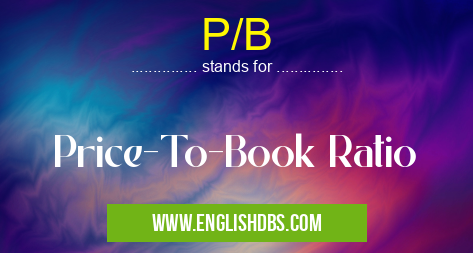What does P/B mean in ACCOUNTING
The Price-to-Book ratio, or P/B ratio, is an important financial metric for assessing the value of a company. It is calculated by dividing the current market price of a company’s stock by its book value per share. The P/B ratio can help investors understand whether they are overpaying or underpaying for a stock and make informed decisions about potential investments.

P/B meaning in Accounting in Business
P/B mostly used in an acronym Accounting in Category Business that means Price-To-Book Ratio
Shorthand: P/B,
Full Form: Price-To-Book Ratio
For more information of "Price-To-Book Ratio", see the section below.
» Business » Accounting
P/B Meaning in Business
The Price-to-Book (P/B) ratio compares the current market price of a company’s stock to its book value per share. Book value per share represents the actual amount that shareholders would receive if all of the assets were liquidated and liabilities paid off at present day values. The higher the P/B ratio, the more expensive the stock is relative to its book value and vice versa. A low P/B ratio indicates that a company may be undervalued as its stock price is lower than it should be compared to its assets. Conversely, a high P/B ratio typically suggests that investors think highly of the company and are willing to pay more than what it’s worth based on its assets alone. Investors should look at other metrics before investing in any company to get a more comprehensive overview of how it may be performing compared to peers and industry standards.
Full Form
Price-To-Book Ratio (P/B)
Essential Questions and Answers on Price-To-Book Ratio in "BUSINESS»ACCOUNTING"
What is a Price-To-Book Ratio?
The Price-To-Book Ratio is a measure of the market value of a company relative to its book value. It is calculated by dividing the current stock price of the company by its per share book value. This ratio can be used to compare companies in different industries and see which one has greater potential for growth.
Why do investors use Price-To-Book Ratios?
Investors use Price-To-Book Ratios to get an indication of how much the market values a company relative to its book value. By comparing this ratio between companies, they can determine which one has better prospects for long term growth.
Is the higher Price-To-Book Ratio always better?
Not necessarily. A higher price to book ratio may indicate that the market values a company more than its actual worth, or it could mean that the stock is overvalued and not worth investing in. Therefore, it is important to look at other financial metrics in addition to this ratio before making any investment decisions.
What factors might cause a high Price-To-Book Ratio?
There are several factors that might lead to an unusually high price to book ratio, such as strong earnings growth or increased demand for the product or service being offered by the company. Other factors can also cause a high P/B ratio including an increase in investor sentiment due to news or rumors related to the company or industry.
What factors might cause low Price-To-Book Ratio?
Factors that can lead to a low P/B ratio include weak financial performance by the company, decreased demand for its products or services, and uncertainty among investors regarding future prospects. An economic recession or poor financial decision making may also contribute towards lowering this ratio.
How does liquidity affect Price-To-Book Ratio?
Liquidity can have both positive and negative effects on price to book ratios since it affects how quickly assets can be converted into cash. A highly liquid balance sheet could result in higher prices relative to its book value since investors expect a quicker return on their investments, while reduced liquidity could drive down prices because investors feel their money is less secure.
Can changes in accounting policies affect Price-To Book Ratio?
Yes, changes in accounting policies such as write offs or revaluations of assets can have an impact on the price to book ratio since they will affect both reported profits and tangible assets on companies' balance sheets. Companies may carry out these changes for various reasons such as restructuring operations or dealing with large losses.
How does debt level affect Price - To - Book Ratio?
High levels of debt will typically lower a company’s P/B ratio since debt increases liabilities while reducing shareholders' equity, even if those debts are noninterest bearing ones with no maturity date attached like convertible debt instruments. On some occasions however, good management and quality earning reports may still make possible for these companies attract interest from investors despite having too much debt.
